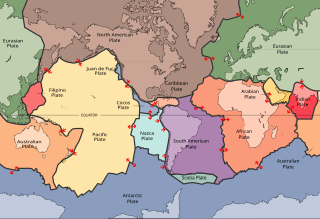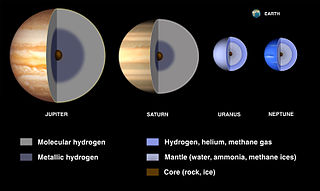
Seismology is the scientific study of earthquakes and the propagation of elastic waves through the Earth or through other planet-like bodies. The field also includes studies of earthquake environmental effects such as tsunamis as well as diverse seismic sources such as volcanic, tectonic, oceanic, atmospheric, and artificial processes such as explosions. A related field that uses geology to infer information regarding past earthquakes is paleoseismology. A recording of earth motion as a function of time is called a seismogram. A seismologist is a scientist who does research in seismology.

Geophysics is a subject of natural science concerned with the physical processes and physical properties of the Earth and its surrounding space environment, and the use of quantitative methods for their analysis. The term geophysics sometimes refers only to the geological applications: Earth's shape; its gravitational and magnetic fields; its internal structure and composition; its dynamics and their surface expression in plate tectonics, the generation of magmas, volcanism and rock formation. However, modern geophysics organizations use a broader definition that includes the water cycle including snow and ice; fluid dynamics of the oceans and the atmosphere; electricity and magnetism in the ionosphere and magnetosphere and solar-terrestrial relations; and analogous problems associated with the Moon and other planets.

A lithosphere is the rigid, outermost shell of a terrestrial-type planet, or natural satellite, that is defined by its rigid mechanical properties. On Earth, it is composed of the crust and the portion of the upper mantle that behaves elastically on time scales of thousands of years or greater. The outermost shell of a rocky planet, the crust, is defined on the basis of its chemistry and mineralogy.

Earth's outer core is a fluid layer about 2,400 km (1,500 mi) thick and composed of mostly iron and nickel that lies above Earth's solid inner core and below its mantle. Its outer boundary lies 2,890 km (1,800 mi) beneath Earth's surface. The transition between the inner core and outer core is located approximately 5,150 km (3,200 mi) beneath the Earth's surface. Unlike the inner core, the outer core is liquid.

A mantle plume is a proposed mechanism of convection of abnormally hot rock within the Earth's mantle. Because the plume head partly melts on reaching shallow depths, a plume is often invoked as the cause of volcanic hotspots, such as Hawaii or Iceland, and large igneous provinces such as the Deccan and Siberian traps. Some such volcanic regions lie far from tectonic plate boundaries, while others represent unusually large-volume volcanism near plate boundaries or in large igneous provinces.

The planetary core consists of the innermost layer(s) of a planet. Cores of specific planets may be entirely solid or entirely liquid, or may be a mixture of solid and liquid layers as is the case in the Earth. In the Solar System, core size can range from about 20% (Moon) to 85% of a planet's radius (Mercury).

The internal structure of the Earth is layered in spherical shells: an outer silicate solid crust, a highly viscous asthenosphere and mantle, a liquid outer core that is much less viscous than the mantle, and a solid inner core. Scientific understanding of the internal structure of the Earth is based on observations of topography and bathymetry, observations of rock in outcrop, samples brought to the surface from greater depths by volcanoes or volcanic activity, analysis of the seismic waves that pass through the Earth, measurements of the gravitational and magnetic fields of the Earth, and experiments with crystalline solids at pressures and temperatures characteristic of the Earth's deep interior.

The core–mantle boundary of the Earth lies between the planet's silicate mantle and its liquid iron-nickel outer core. This boundary is located at approximately 2891 km (1796 mi) depth beneath the Earth's surface. The boundary is observed via the discontinuity in seismic wave velocities at that depth due to the differences between the acoustic impedances of the solid mantle and the molten outer core. P-wave velocities are much slower in the outer core than in the deep mantle while S-waves do not exist at all in the liquid portion of the core. Recent evidence suggests a distinct boundary layer directly above the CMB possibly made of a novel phase of the basic perovskite mineralogy of the deep mantle named post-perovskite. Seismic tomography studies have shown significant irregularities within the boundary zone and appear to be dominated by the African and Pacific large low-shear-velocity provinces (LLSVPs).

Geothermal gradient is the rate of increasing temperature with respect to increasing depth in the Earth's interior. Away from tectonic plate boundaries, it is about 25–30 °C/km (72-87 °F/mi) of depth near the surface in most of the world. Strictly speaking, geo-thermal necessarily refers to the Earth but the concept may be applied to other planets.

Earth's inner core is the innermost geologic layer of the Earth. It is primarily a solid ball with a radius of about 1,220 kilometres, which is about 20% of the Earth's radius and 70% of the Moon's radius.

In geology, the mesosphere refers to the part of the Earth's mantle below the lithosphere and the asthenosphere, but above the outer core. The upper boundary is defined by the sharp increase in seismic wave velocities and density at a depth of 660 kilometers (410 mi). At a depth of 660 km, ringwoodite (gamma-(Mg,Fe)2SiO4) decomposes into Mg-Si perovskite and magnesiowüstite. This reaction marks the boundary between upper mantle and lower mantle. This measurement is estimated from seismic data and high-pressure laboratory experiments.

Geodynamics is a subfield of geophysics dealing with dynamics of the Earth. It applies physics, chemistry and mathematics to the understanding of how mantle convection leads to plate tectonics and geologic phenomena such as seafloor spreading, mountain building, volcanoes, earthquakes, faulting and so on. It also attempts to probe the internal activity by measuring magnetic fields, gravity, and seismic waves, as well as the mineralogy of rocks and their isotopic composition. Methods of geodynamics are also applied to exploration of other planets.

The low-velocity zone (LVZ) occurs close to the boundary between the lithosphere and the asthenosphere in the upper mantle. It is characterized by unusually low seismic shear wave velocity compared to the surrounding depth intervals. This range of depths also corresponds to anomalously high electrical conductivity. It is present between about 80 and 300 km depth. This appears to be universally present for S waves, but may be absent in certain regions for P waves. A second low-velocity zone has been detected in a thin ≈50 km layer at the core-mantle boundary. These LVZs may have important implications for plate tectonics and the origin of the Earth's crust.
The Adams–Williamson equation, named after L. H. Adams and E. D. Williamson, is an equation used to determine density as a function of radius, more commonly used to determine the relation between the velocities of seismic waves and the density of the Earth's interior. Given the average density of rocks at the Earth's surface and profiles of the P-wave and S-wave speeds as function of depth, it can predict how density increases with depth. It assumes that the compression is adiabatic and that the Earth is spherically symmetric, homogeneous, and in hydrostatic equilibrium. It can also be applied to spherical shells with that property. It is an important part of models of the Earth's interior such as the Preliminary reference Earth model (PREM).

Large low-shear-velocity provinces, LLSVPs, also called LLVPs or superplumes, are characteristic structures of parts of the lowermost mantle of the Earth. These provinces are characterized by slow shear wave velocities and were discovered by seismic tomography of the deep Earth. There are two main provinces: the African LLSVP and the Pacific LLSVP. Both extend laterally for thousands of kilometers and possibly up to 1000 km vertically from the core-mantle boundary. The Pacific LLSVP has specific dimensions of 3000 km across and 300 m higher than the surrounding ocean-floor, and is situated over four hotspots that suggest multiple mantle plumes underneath. These zones represent around 8% of the volume of the mantle. Other names for LLSVPs include superwells, thermo-chemical piles, or hidden reservoirs. Some of these names, however, are more interpretive of their geodynamical or geochemical effects, while many questions remain about their nature.
Ultra low velocity zones (ULVZs) are patches on the core-mantle boundary that have extremely low seismic velocities. The zones are mapped to be hundreds of kilometers in diameter and tens of kilometers thick. Their shear wave velocities can be up to 30% lower than surrounding material. The composition and origin of the zones remain uncertain. The zones appear to correlate with edges of the African and Pacific Large low-shear-velocity provinces (LLSVPs) as well as the location of hotspots.

Inner core super-rotation is a theorized eastward rotation of the inner core of Earth relative to its mantle, for a net rotation rate that is faster than Earth as a whole. A 1995 model of Earth's dynamo predicted super-rotations of up to 3 degrees per year; the following year, this prediction was supported by observed discrepancies in the time that p-waves take to travel through the inner and outer core.
The lower mantle represents approximately 56% of the Earth's total volume and is located 660–2900 km below the Earth's surface in between the transition zone and the outer core. The Preliminary reference Earth model (PREM) separates the lower mantle into three sections, the uppermost (660–770 km), mid-lower mantle (770–2700 km), and the D" layer (2700–2900 km). Pressures and temperature at the lower mantle ranges from 24-127 GPa and 1900-2600K. It has been proposed that the composition of the lower mantle is pyrolitic containing three major phases of bridgmanite, ferropericlase and calcium-silicate perovskite. The pressure conditions in the lower mantle was shown to induce a spin transition of iron-bearing bridgmanite and ferropericlase which may affect both mantle plume dynamics and lower mantle chemistry.















